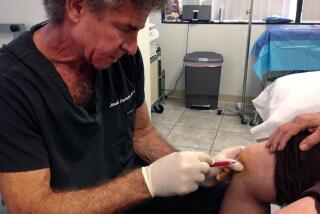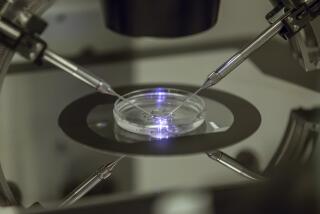Stem cells, the next step
- Share via
In unsettled times, perhaps it’s appropriate to move cautiously on some fronts, aiming for consensus rather than contention. If that’s the case, the Obama administration made a savvy move with its compromise draft rules on embryonic stem cell science: It greatly expanded the number of embryos available for federally funded research, but refused to open the door to funding research on embryos created for that purpose.
It was an important step forward,but not the kind of bold move promised by President Obama when he pledged to “base our public policies on the soundest science” rather than on politics.
The compromise proposed by the National Institutes of Health would allow federal money to be used for research on stem cell lines from surplus embryos that were created through fertility treatments. That could bring the number of authorized stem cell lines into the hundreds or even thousands, an impressive expansion from the two dozen or so allowed under the Bush administration.
The NIH also developed ethics guidelines for the use of those embryos, requiring that the donors give fully informed, written consent that can be reversed up until the research begins. Such high standards are necessary to prevent abuses, but as written, the regulations do not address the use of fertility clinic embryos that were created before such rules became commonplace elsewhere. The NIH should give thought to creating a second layer of guidelines for those embryos, perhaps by requiring documented searches for the potential donors.
The new NIH rules would not allow the use of federal money for studying stem cell lines derived from embryos created specifically for research. Such research might involve attempts to produce genetically matched organs for transplant or stem cell lines that reflect racial and ethnic diversity.
The NIH’s stance is inherently contradictory. The viewpoint of those who oppose embryonic stem cell research is that it ends human life by destroying embryos made up of just a few cells. Under that argument, the act would be just as objectionable whether those embryos already were slated for destruction or not; their being “surplus” doesn’t change that. And if the destruction is not morally objectionable, then it shouldn’t matter whether the embryos were created for research or another purpose.
The Obama administration sidesteps the issue by saying correctly that its draft rules reflect public opinion. That’s a pragmatic approach, but not one informed mainly by science. The rules are best seen as a good start that might move public consensus toward a more comprehensive stem cell policy that includes supporting work on any stem cell lines created under ethics guidelines.
More to Read
A cure for the common opinion
Get thought-provoking perspectives with our weekly newsletter.
You may occasionally receive promotional content from the Los Angeles Times.










